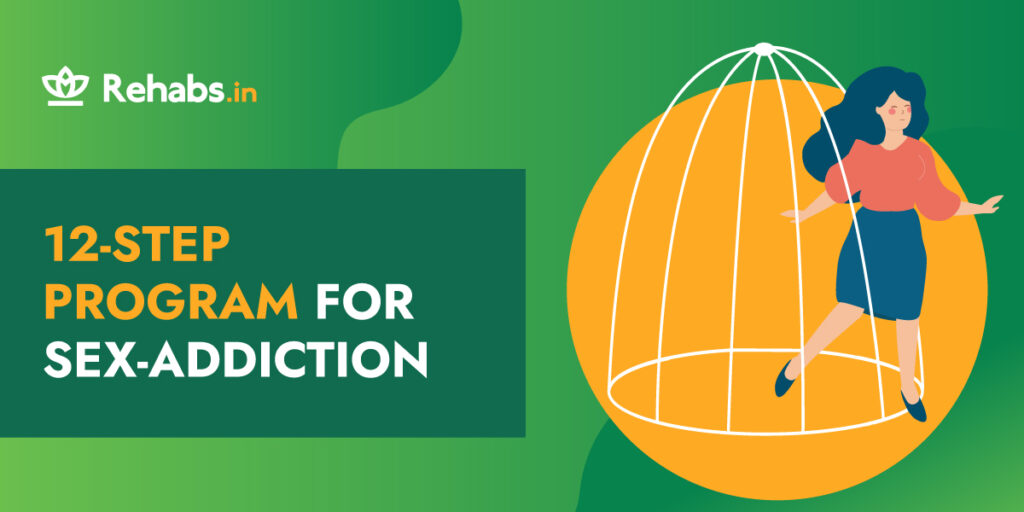12-step program for sex-addiction

12-Step Programs for Sex Addiction Recovery: A Comprehensive Guide
Jatin has always felt a relentless pull towards his desires, a compulsive need that consumed his thoughts and actions. For years, he battled in silence, grappling with the overwhelming grip of sex addiction. The stigma surrounding his condition weighed heavily on him, making him feel isolated and ashamed. Friends and family often misunderstood his behaviour, labelling him promiscuous or morally flawed. But Jatin knew that his addiction was a natural and crippling condition that needed professional help. One day, through a friend, he found out about a 12-step program for sex addiction.
Sex addiction is a complex and misunderstood condition affecting countless individuals and their relationships. 12-step programs for sex addiction offer a structured path towards healing, self-discovery, and lasting recovery. Sex addiction in females is also prevalent but not talked about much. Whether you’re personally dealing with sex addiction or seeking to support someone on this path, this guide aims to provide you with the knowledge and tools necessary for a successful recovery.
Understanding Sex Addiction
According to the 11th edition of the International Classification of Disorders (ICD-11), compulsive Sexual Behavior Disorder (CSBD) is when someone can’t control their intense, repetitive sexual urges, leading to repetitive sexual actions. Symptoms can include sexual activities becoming the main focus even neglecting health, personal care, and other responsibilities. They might try to stop but fail repeatedly and continue despite adverse consequences. This pattern lasts at least six months and causes significant distress or impairment in various aspects of life. It’s important to note that pain based solely on moral judgments about these urges or behaviours doesn’t meet this requirement.
The results of a survey involving 142 married individuals dealing with sex addiction and coaddiction indicate that couples facing crises stemming from compulsive sexual behaviors can improve their relationship’s chances of survival by both identifying as “addict” and “coaddict,” and attending 12-step meetings.
Recognising the signs and symptoms of sex addiction
Compulsive Sexual Behavior Disorder is characterised by a persistent inability to control strong, repetitive sexual urges, resulting in repetitive sexual actions. This pattern includes:
- Making repetitive sexual behaviour the central focus of life, neglecting other responsibilities and interests.
- Repeatedly trying but failing to control or reduce this behaviour.
- Continuing the behaviour despite negative consequences, like relationship conflicts, legal problems, or health issues.
- Engaging in the behaviour even when it doesn’t bring satisfaction.
- This pattern persists for at least six months.
- Another mental disorder, medical condition, or substance use doesn’t cause it.
- It causes significant distress or impairment in various life areas beyond moral judgment.
People with this disorder may express it through various behaviours like sexual activities with others, masturbation, pornography use, or online sexual interactions. Often, these behaviours are triggered by emotional states like depression or anxiety. Sometimes, individuals may refer to themselves as ‘sex addicts’ or describe their behaviour as ‘compulsive’ due to moral or social judgments.
ICD further tries to distinguish between CSBD as a disorder and a high sex drive, which might be normal. This diagnosis applies when a person has intense, repetitive sexual urges that they can’t control, leading to repetitive sexual actions. These actions cause significant distress or problems in different parts of life. People with a strong interest in sex who can control their behaviour and aren’t distressed or impaired shouldn’t be diagnosed with Compulsive Sexual Behavior Disorder. It also shouldn’t be used to describe high levels of sexual interest and behaviour, like masturbation, that are common in adolescents, even if they feel distressed.
Acknowledging the presence of a sex addiction problem is the first step toward healing. Seeking help and support from professionals and support groups is essential for addressing this challenging condition.
Overview of 12-Step Programs
12-step programs are a time-tested approach to addiction recovery. They are based on a set of guiding principles that provide a structured framework for individuals seeking to overcome their addiction. These programs emphasise self-help, peer support, and spiritual growth.
While originally designed for alcoholics, the 12-step model has proven highly adaptable and effective in addressing various forms of addiction, including sex addiction. We’ll explore how these principles can be tailored to address the unique challenges of sex addiction recovery.
Key principles of 12-step programs:
- Admitting Powerlessness: Acknowledging that addiction has taken control of one’s life.
- Surrender to a Higher Power: Surrendering control to a higher power, fostering hope and faith.
- Personal Inventory: Encouraging honest self-reflection and accountability for past actions.
- Making Amends: Apologizing and making things right with those harmed by one’s actions.
- Continuous Self-Reflection: Addressing new issues promptly and continuously improving oneself.
- Helping Others: Fostering a sense of fellowship and supporting others on the path to recovery.
- One Day at a Time: Focusing on daily sobriety goals to reduce anxiety.
- Group Support: Sharing experiences and challenges with peers in meetings and fellowship.
Benefits and limitations of 12-step programs for sex addiction
12-step programs for sex addiction offer valuable benefits such as structured guidance, a supportive community, and a non-judgmental environment. Participants find solace in the shared experiences of peers, fostering a sense of belonging. The spiritual component can be a source of hope, and the programs promote accountability and amends-making, aiding in self-improvement and relationship repair.
However, these programs have limitations. Spirituality requirements may not align with everyone’s beliefs, and their effectiveness varies from person to person. Maintaining anonymity can be challenging, and the focus may not address underlying psychological issues or trauma. Additionally, finding gender-specific groups can be difficult in some regions. While 12-step programs have been instrumental in many individuals’ recovery journeys, they may not be a universal solution, and alternative or complementary therapies may be necessary for some.
Ultimately, the treatment choice for sex addiction should be based on an individual’s unique needs and preferences. Some may find 12-step programs highly effective, while others may benefit from a combination of therapies or alternative approaches.
The Role of 12-Step Programs in Sex Addiction Recovery
Establishing a Supportive and Non-Judgmental Environment
12-step programs offer a sanctuary for those battling sex addiction. These groups create a safe haven where shame and secrecy can be shed. In this accepting space, participants can openly share their experiences without fear of judgment. Here, understanding and empathy replace isolation and stigma. This atmosphere of acceptance encourages honesty and vulnerability, which are vital for the recovery journey.
Providing a Structured Framework for Self-Reflection and Personal Growth
Recovery from sex addiction demands profound introspection and growth. 12-step programs provide a structured framework for this transformative process. Step by step, individuals explore their past actions, acknowledge the harm caused, and make amends. This structured self-reflection uncovers addiction’s roots, promotes responsibility, and fuels personal growth and healing.
Fostering a Sense of Fellowship and Connection with Others in Similar Situations
Within these programs, individuals find a community that shares their challenges. Isolation gives way to camaraderie, creating a network of support and encouragement. Participants lean on each other for guidance and strength. This sense of connection reminds them they’re not alone and recovery is attainable with the support of others.
Step 1: Admitting Powerlessness and Unmanageability
In the path to recovery from sex addiction through a 12-step program, Step 1 is the pivotal starting point. It involves three essential components:
Acknowledging the Presence of a Sex Addiction Problem: This step requires individuals to bravely admit they have a problem with sex addiction. It’s an act of self-awareness, recognising that they’ve lost control over their sexual behaviours, causing harm and distress.
Understanding the Consequences and Unmanageability: Beyond acknowledging the problem, Step 1 urges thoroughly examining the addiction’s consequences. This self-reflection unveils the profound impact on personal, family, social, educational, and occupational aspects. It reveals the urgency for change.
Embracing the Need for Surrender and Seeking Help: The final part is about surrendering the futile struggle to control the addiction. It’s not admitting defeat but a humble recognition that overcoming addiction requires help beyond personal willpower. This surrender paves the way for seeking support from a higher power and a supportive 12-step community.
Step 1 lays the foundation for the transformative journey towards recovery. It’s an act of courage, self-awareness, and acceptance, signalling the commitment to change and healing.
Steps 2-3: Finding Hope and Turning to a Higher Power
In the journey of recovery from sex addiction within a 12-step program, Steps 2 and 3 play a significant role in fostering hope, belief, and spirituality. Step 2 emphasises the crucial role of hope and belief in the recovery process. After acknowledging powerlessness in Step 1, individuals must cultivate hope to overcome their addiction. Belief in the possibility of recovery becomes their guiding light, offering motivation during challenging times.
Step 3 expands on the concept of a higher power, allowing for diverse interpretations. It can represent a traditional deity, the collective strength of the 12-step group, or a personal understanding of spirituality. This step respects individual beliefs, fostering a connection with a higher purpose or force transcending personal limitations.
Central to Step 3 is the act of surrendering control to the chosen higher power. This surrender isn’t about giving up personal agency but acknowledging that certain aspects of recovery are beyond one’s control. It’s an exercise in trust, leaning into the belief that the higher power will guide and support the healing journey.
Steps 4-9: Taking Personal Inventory and Making Amends
In the journey of recovery from sex addiction within a 12-step program, Steps 4 through 9 constitute a profound transformative phase. Step 4 initiates this journey by guiding individuals to conduct a comprehensive self-inventory of their past behaviours and the resulting consequences. It’s not a surface-level examination but a deep dive into one’s actions, demanding unwavering honesty and courage.
Step 5 involves sharing this inventory with another person or a higher power, a vulnerable act. Step 6 prepares individuals to take ownership of their actions, admit their shortcomings, and become willing to change. Steps 7 to 9 are about taking action. In Step 7, individuals humbly ask a higher power to remove their shortcomings. Step 8 prompts them to list those they’ve harmed and be ready to make amends. Finally, in Step 9, concrete steps are taken to make those amends, aiming to mend relationships and rectify past wrongs.
Steps 10-12: Maintaining Accountability and Helping Others
In the journey of recovery from sex addiction through a 12-step program, Steps 10 to 12 are crucial in sustaining progress and fostering a sense of community. Step 10 encourages regular self-reflection and the prompt admission of wrongdoings. It emphasises the importance of not allowing resentments or negative patterns to linger, promoting continuous personal growth and accountability.
Step 11 underscores daily self-care and spiritual connection. Through practices like meditation or prayer, individuals maintain their spiritual and emotional well-being. Seeking wisdom and guidance for continued recovery is encouraged, reinforcing the idea that self-care is an ongoing commitment.
Step 12 represents the pinnacle of the journey. It’s about giving back and assisting others in the recovery community. This step fosters a sense of fellowship and reminds individuals of their growth by supporting fellow journeyers. Through sponsorship, sharing experiences, or offering guidance, Step 12 highlights the strength of community and the power of helping others.
Addressing Challenges and Setbacks
Navigating Triggers and Relapse Prevention Strategies: Recovery from sex addiction is a journey marked by growth and healing, but it’s not without its hurdles. Triggers, situations that provoke addictive urges, are common in sex addiction recovery. Recognising and managing these triggers is crucial. Individuals must develop relapse prevention strategies, like identifying risky situations, building coping skills, and seeking support from peers and sponsors to stay resilient. It is also important to learn how to have a healthy sex life after recovery.
Overcoming Shame and Stigma: Shame and stigma often surround sex addiction, causing guilt and isolation. Overcoming these emotions entails therapy, counselling, and participation in supportive, non-judgmental groups. Understanding that addiction isn’t a moral failing but a medical condition helps dispel stigma and fosters self-acceptance.
Seeking Professional Help and Support: Professional help is invaluable during tough times. Therapists, counsellors, and addiction specialists offer tailored guidance. Relying on the 12-step program and the recovery community for support is essential. Setbacks are part of recovery; seeking help during these moments reflects strength, not weakness.
Complementary Support and Resources in Sex Addiction Recovery
The Importance of Therapy or Counseling Alongside 12-Step Programs
Therapy or counselling is essential. It offers a safe, personalised space to address the root causes of sex addiction, psychological issues, and coping strategies. Combining therapy with 12-step programs ensures a holistic recovery approach, addressing both emotional and behavioural aspects.
Utilising Group Support Through Meetings and Fellowships
Group support is powerful. Meetings and fellowships connect individuals on the same journey, fostering understanding and motivation. Group support provides encouragement, accountability, and guidance, whether in-person or virtual.
Exploring Additional Resources and Tools
Additional resources like self-help books, online forums, and apps complement recovery. They offer flexibility and customisation, allowing individuals to tailor their recovery plan to their unique needs and preferences. This multifaceted approach strengthens recovery, fosters community, and provides a diverse toolkit for lasting change.
If you or someone you know suffers from sex addiction, know that help is available. You can browse our list of treatment centres across India here.
Sources:
Efrati, Y., & Gola, M. (2018). Compulsive sexual behavior: A twelve-step therapeutic approach. Journal of Behavioral Addictions, 7(2), 445–453. https://doi.org/10.1556/2006.7.2018.26
ICD-11 for Mortality and Morbidity Statistics. (n.d.-b). https://icd.who.int/browse11/l-m/en
Schneider, J. P., & Schneider, M. (1996). Couple recovery from sexual addiction / co addiction: Results of a survey of 88 marriages. Sexual Addiction and Compulsivity: The Journal of Treatment and Prevention, 3(2), 111–126. https://doi.org/10.1080/10720169608400106
Sex Addicts Anonymous. (n.d.). The Twelve Steps – SAA. SAA. https://saa-recovery.org/our-program/the-twelve-steps/














